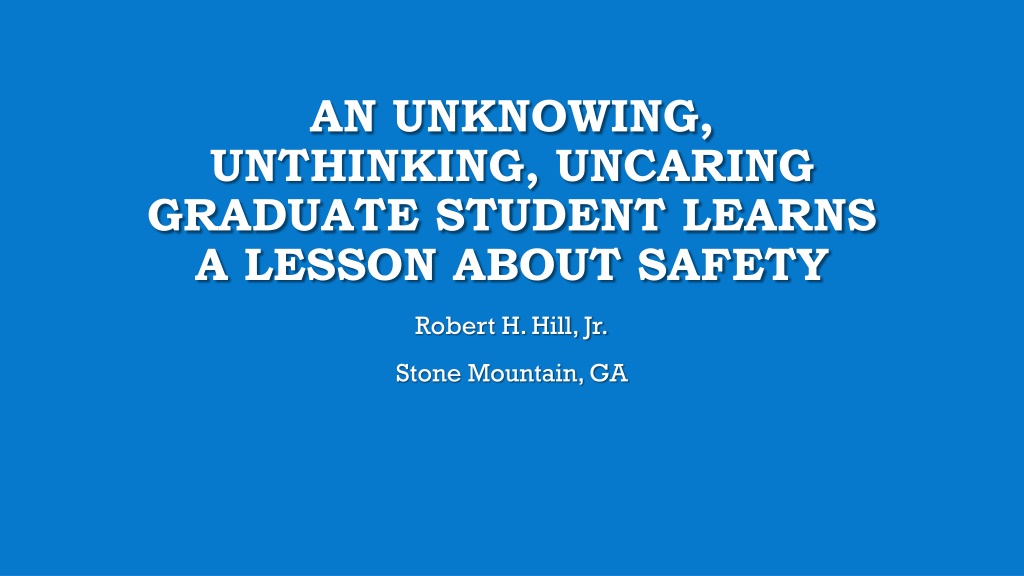Importance of Safety Education for Graduate and Undergraduate Students
Graduate and undergraduate students often lack safety knowledge and ethics, emphasizing the need for safety education over mere training. Safety education builds critical thinking, promotes safety ethics, and prepares individuals to handle future safety issues. Incorporating safety teachings throughout the curriculum is vital to instill a safety ethic and prevent risky behaviors. The incident involving a graduate student highlights the repercussions of overlooking safety protocols.
Download Presentation

Please find below an Image/Link to download the presentation.
The content on the website is provided AS IS for your information and personal use only. It may not be sold, licensed, or shared on other websites without obtaining consent from the author. Download presentation by click this link. If you encounter any issues during the download, it is possible that the publisher has removed the file from their server.
E N D
Presentation Transcript
AN UNKNOWING, UNTHINKING, UNCARING GRADUATE STUDENT LEARNS A LESSON ABOUT SAFETY Robert H. Hill, Jr. Stone Mountain, GA
UNDERGRADUATES NEED A SAFETY EDUCATION!1 Graduates: Lack safety knowledge/understanding Lack safety ethics (caring/thinking) Don t know that they don t know Academic institutions: Left safety education out of curriculum Substituted safety training for safety education Safety education and safety training are NOT equivalent 1RH Hill, J Chem Ed 93 1495-1498 (2016)
UNDERGRADUATES NEED A SAFETY EDUCATION! Education Training Skill building 1. 1. Mind building 2. Behavior, rules 2. Thought building, critical thinking 3. Specific applications 3. Principles, general applications 4. Short-term learning 4. Long-term learning 5. Provided by employers 5. Taught by educators 6. Specific required skills, knowledge to do jobs 6. Provides basic knowledge, understanding for future careers
UNDERGRADUATES NEED A SAFETY EDUCATION! Safety education provides two things: THE SAFETY ETHIC: I value safety, work safely, teach safety, prevent at- risk behavior, promote safety, and accept responsibility for safety. Knowledge, understanding (critical thinking) to handle future safety issues, AND Caring/thinking about safety (ethics) with safety teaching throughout curriculum Find ways to fold principle-based safety education into curriculum Teach safety in all lab-based sciences RH Hill, J Chem Health Safety, 20 8-11 (2003)
R.A.M.P UP FOR SAFETY Four Principles of Safety Recognize hazards Assess risks of hazards Minimize risks of hazards Prepare for emergencies R.A.M. P. R Hill, D Finster. Laboratory Safety for Chemistry Students, 2nd Edition, John Wiley & Sons, Hoboken, NJ, 2016
ONCE UPON A TIME IN A LAB WHERE CHEMISTRY HAPPENED Graduate student (2nd yr) synthetic organic research Lab/teaching assistant (undergraduate & graduate) Safety instruction Yearly 1-hr review of Dept. safety rules PI s safety reminder Be careful! Did not know that he did not know about safety
THE INCIDENT Needed to purify a solid synthesis product Laboratory hood too cluttered for use In a hurry, did not want to clean up hood Recrystallization in beaker on open bench using hot plate Began heating product in solvent - diethyl ether
THE INCIDENT Solvent (ether) began to boil on hot plate Then he heard the THUNDEROUS CLICK! Instantly a flash fire ran up his right arm, burning hair off arm, eyebrows He staggered backwards in shock Only then did he realize that he had not recapped the 5-gal can of ether It looked like a giant Bunsen burner with a flame about 12 inches high Another graduate student extinguished the fire
USING RAMP TO ANALYZE INCIDENT Recognize hazards not done (Hazard is potential source of danger or harm) Assess risks of hazards not done Minimize risks of hazards not done 1. Housekeeping Prepare for emergencies not done 2. Cutting corners hurried, lazy? 3. Flammable on open bench 4. Hot plate not spark proof 5. Carelessness Failed to recap ether 6. Not thinking/caring about safety
WHY DID THIS HAPPEN? WHY? Hot plate ignited flammable vapors on open bench Did not understand properties of flammable chemicals WHY? Cut corners Poor housekeeping in hood; in a hurry or too lazy to clean up hood WHY? Did not recognize and understand multiple hazards WHY? Did not receive a laboratory safety education AND did not think about safety (missing safety ethic) WHY? Safety education missing from chemistry curriculum
TEACHING THE R OF RAMP Recognizing and understanding hazards Critical for safe chemistry Recognize hazards Assess risks of hazards Minimize risks of hazards Prepare for emergencies Doesn t just happen needs to be taught Learning about hazards builds strong safety ethic (caring/thinking about safety) Without R , RAMP does not work Assessing, Minimizing, Preparing must be taught Integrate Safety Education into undergraduate/graduate educational processesR.A.M. P.
























